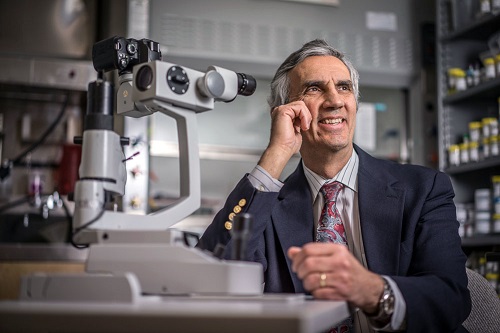
The John A. Moran Eye Center’s Nick Mamalis, MD, fondly recalls the first time he attended a meeting of the group that would become today’s 8,000-member American Society of Cataract and Refractive Surgery (ASCRS).
It was 35 years ago, a time when the field of ophthalmology itself was rapidly evolving.
"I was just a fellow back then, but I really saw that this group was a place where we could improve patient care—where cataract surgery research was going on and where research into intraocular lenses would go on as the field developed," said Mamalis. "Never in my wildest dreams could I have imagined that I would become its president."
"ASCRS is truly the society for all anterior segment surgeons, regardless of the volume or complexity of the surgeries they do," said Mamalis, who also co-directs the Intermountain Ocular Research Center at Moran. "If you’re a surgeon who really wants to update your surgical techniques, patient care, and equipment, ASCRS is the place to go. It offers a broad range of learning opportunities, whether that is a website, seminar, meeting, or our journal."
Supporting Research and Outreach Care
Mamalis also pointed to ASCRS as an outreach leader, supporting surgeons who want to help patients who can’t afford surgery.
"You don’t have to fly to Africa to help people in need; you can do it right in your own community," he said. "The ASCRS Operation Sight initiative, which provides no-cost cataract surgery, was modeled on some of the work we do here at Moran. If you’ve got patients in need and want to do outreach at your eye center, they can qualify patients and even help with some monetary support."
Mamalis will discuss his vision for his presidency during the ASCRS annual meeting. There, he’ll also present the results of a yearly member survey that sheds light on rare surgeries that remove an intraocular lens after it’s been implanted into the eye.
The 2018 survey shows surgeons removed multifocal intraocular lenses, used to correct vision at all distances, more frequently than standard lenses and for different reasons.
"Multifocal lenses are being explanted due to visual aberrations such as glare, halos or ‘Vaseline’ vision," he said. "What that tells us is that surgeons need to be very careful in choosing the right patient for a multifocal lens and spending time talking with the patient pre-operatively to let them know what to expect after the surgery."
Mamalis is internationally known for his work at the Intermountain Ocular Research Center, a non-profit laboratory that conducts intraocular lens research and helps to develop new lens materials and designs for clinicians and companies worldwide. In 2018, research conducted by Mamalis led to new, evidence-based guidelines for the cleaning and sterilization of intraocular surgical instruments to prevent an inflammatory syndrome known as TASS.
Mamalis is the second president of ASCRS to come from the Moran Eye Center; Alan S. Crandall, MD, is a former president.
Moran Researchers at the ASCRS 2019 Annual Meeting
Moran clinicians and researchers will present their work and lead instructional workshops and symposium on a variety of topics at the upcoming ASCRS Annual Meeting, to be held May 5-7 in San Diego.
Topics include global efforts to address avoidable blindness, evaluations of new intraocular lens designs, and optimal settings for phacoemulsification machines used to remove the eye’s clouded lens during cataract surgery.
View a list of their scheduled presentations here.